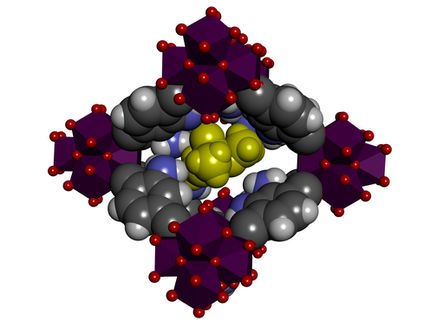Engineering antidotes to chemical weapons
chemical weapons and other toxic agents including pesticides pose a serious health threat worldwide, whether they are deliberately released or emitted by accident from industrial chemical operations during processing, shipping, or storage.
Jin Montclare, an associate professor in the Department of Chemical and Biomolecular Engineering at the NYU Tandon School of Engineering is participating in a U.S. government program to thwart these agents by improving upon compounds known to neutralize them. Montclare was awarded a grant by the U.S. government's CounterACT (Countermeasures Against Chemical Threats) program under the National Institutes of Health, which supports research to prevent and treat exposure.
The $349,040 grant furthers Montclare's work on phosphotriesterase (PTE), a compound that can deactivate the neurotoxic agent organophosphorus, the active compound in a number of pesticides and a rogue's gallery of chemical warfare agents like VX, the most toxic nerve agent ever created, which is considered a weapon of mass destruction. As was demonstrated in the assassination this year of Kim Jong-nam, the half brother of North Korea's leader, a fraction of a drop of VX absorbed through the skin is fatal.
V-series agents like VX, VR, VM, and Sarin -- used in the Iran-Iraq War during the 1980s, in attacks in Japanese cities by the Aum Shinrikyo cult in the 1990s, and by the Syrian government on its citizens in 2013 -- work by inhibiting the enzyme acetylcholinesterase (AChE), which catalyzes the breakdown of acetylcholine and other neurotransmitters.
When this enzyme is blocked, toxic accumulation of acetylcholine in the synapses between neurons and muscle cells follows, resulting in hyper-stimulation of neural pathways, which in turn causes ataxia (loss of muscle control), coma, convulsions and death. Even with expedient treatment, which involves administering a cocktail of atropine, oximes and benzodiazepines, mortality rates are as high as 40 percent.
While PTE, a hydrolyzing agent, is effective across a range of compounds including organophosphorus, its activity varies considerably from agent to agent and it possesses a short half-life. Montclare's research is aimed at creating variants of PTE that are stable, robust and effective in neutralizing a plethora of toxic chemical agents.
"Our rationale is that once we identify fluorinated PTE variants active for V-agents, they can be tested in vivo for therapeutic efficacy," said Montclare. "This approach alone or in combination with existing cocktails will improve the efficacy and decrease mortality rates."
Montclare's work, in collaboration with Dr. Tamara Otto at the U.S. Army Medical Research Institute of Chemical Defense (USAMRICD) at the Aberdeen Proving Ground, takes a two-pronged approach to modifying PTE: The researchers incorporated a protein/fluorine complex into PTE that confers stability and longer half-life; and, with Richard Bonneau, Director of the NYU Center for Data Science , they are using computational biology software suite Rosetta, which includes algorithms for modeling and analysis of protein structures, to re-engineer PTE's active receptor site to "recognize" and bind more easily with a variety of V-agents.
Bonneau explains, "This work really represents an ideal application of computational protein design. We are really excited to work to make new design codes that mesh well with the bioengineering side of his project."
Montclare said the team will use experimental results to investigate a second generation set of fluorinated-PTE variants.
"This feedback-based approach will allow us to refine Rosetta to improve specific activity for the V-agents, making fluorinated-PTE variants even more effective based on insights from activity and stability data."
Topics
Organizations
Other news from the department science

Get the chemical industry in your inbox
By submitting this form you agree that LUMITOS AG will send you the newsletter(s) selected above by email. Your data will not be passed on to third parties. Your data will be stored and processed in accordance with our data protection regulations. LUMITOS may contact you by email for the purpose of advertising or market and opinion surveys. You can revoke your consent at any time without giving reasons to LUMITOS AG, Ernst-Augustin-Str. 2, 12489 Berlin, Germany or by e-mail at revoke@lumitos.com with effect for the future. In addition, each email contains a link to unsubscribe from the corresponding newsletter.




























































